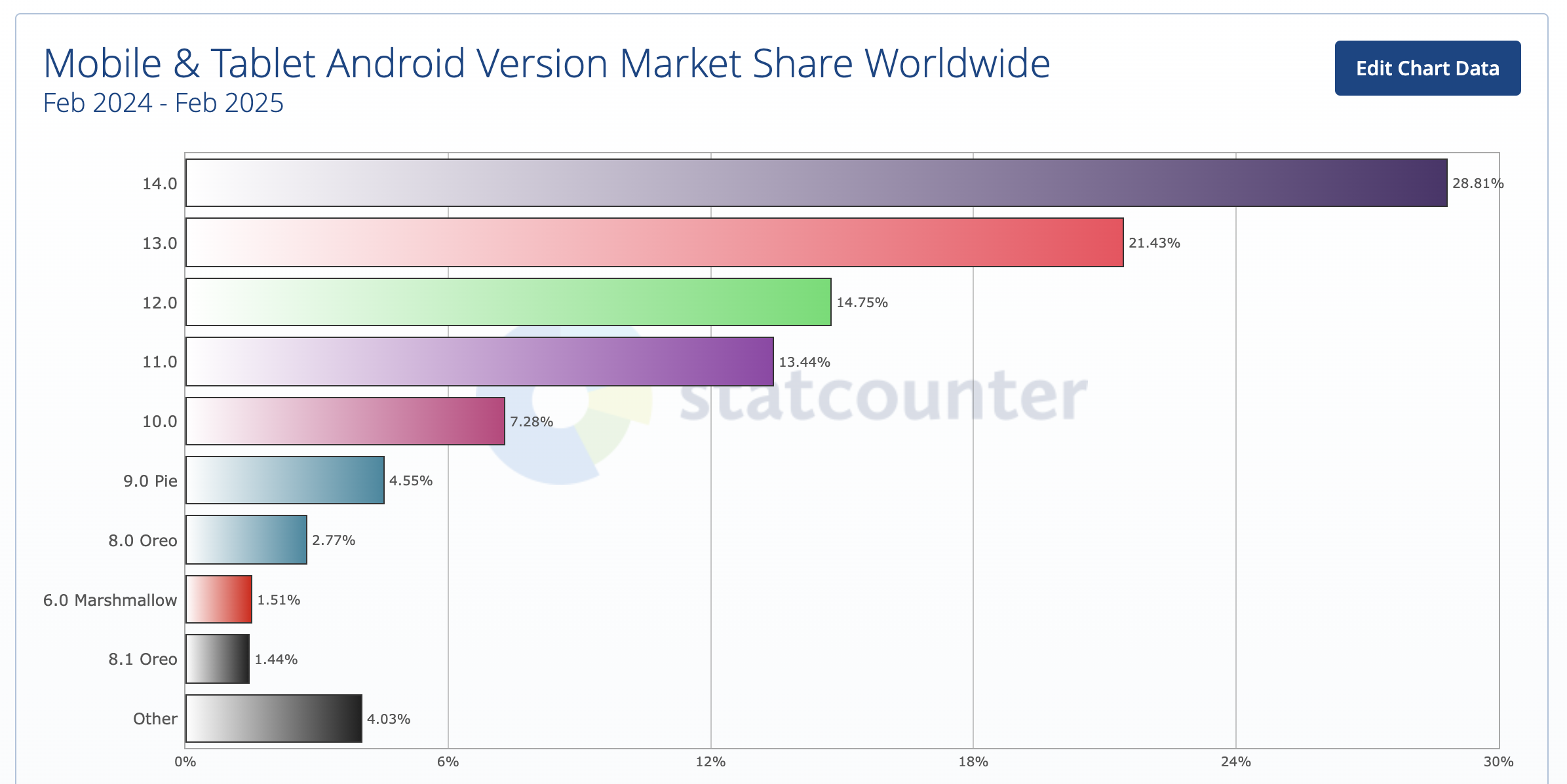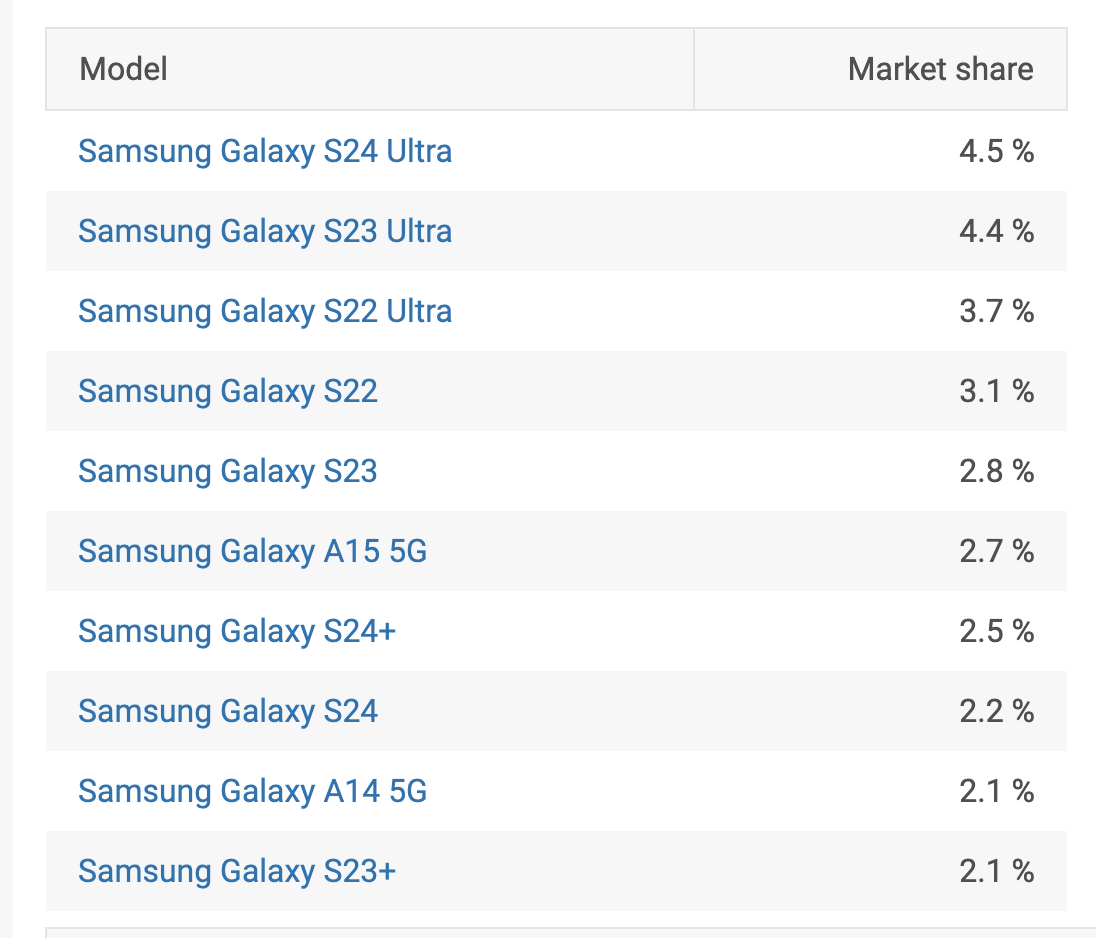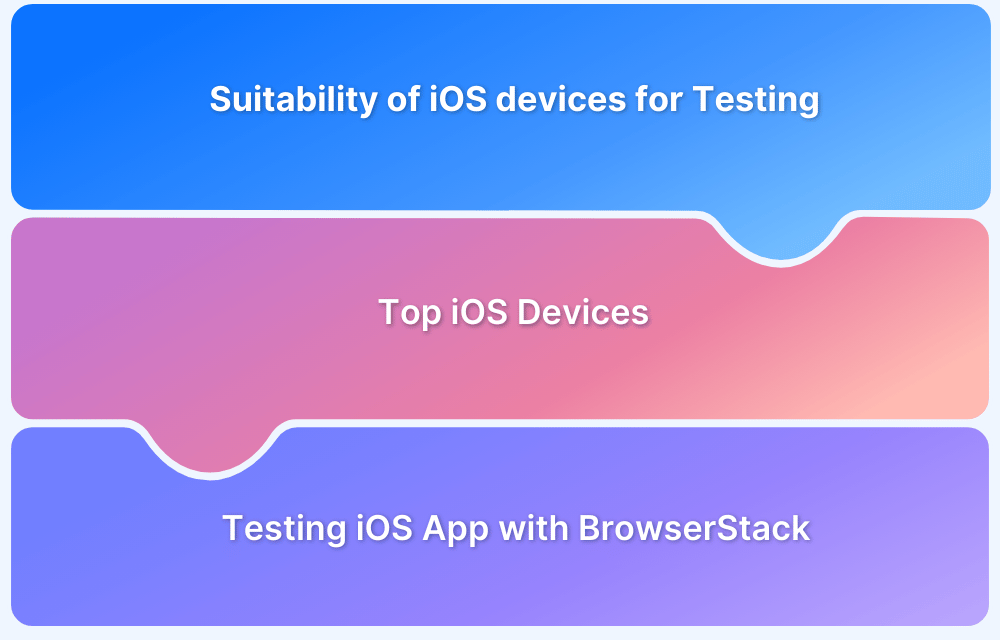Selecting a mobile device is the key to retaining end-users and evaluating the adaption rate. Apps must prove their worth to make a presence on end users’ mobile devices. An app’s security, performance, user interface, and navigation are a few essential factors that help in user retention.
Overview
Factors for Selecting Devices For Mobile App Testing
- Technical Parameters like resolution, camera quality etc.
- Target Audience and Popular Devices
- Device Matrix for comparison
- Operating Systems
- Screen Size & Resolution
- Device Manufacturers
- Market Share
This article dives deep into how you can select devices for mobile app testing.
What is Mobile App Testing?
Mobile app testing is the process of checking a mobile application (Android or iOS) to ensure it works correctly, meets user expectations, and performs well before being released. It helps validate that the app meets both technical and business requirements while simultaneously delivering a smooth experience across different devices and operating system versions. This testing involves checking various aspects such as functionality, usability, performance, security, and compatibility.
Since mobile apps run on diverse devices with different screen sizes, hardware configurations, and operating systems (like Android and iOS), thorough testing is crucial to detect and fix potential issues before the app reaches users.
Testing can be done manually or through automation using tools like Appium, Espresso, XCUITest, or BrowserStack App Automate. By performing rigorous mobile app testing, businesses can enhance app quality, improve user satisfaction, and prevent costly defects post-release.
Importance of Device Selection in Mobile Testing
Device selection is crucial in mobile app testing, as it ensures applications function seamlessly across different devices.
With a wide variety of smartphones and tablets available, testing on a carefully chosen set of devices helps identify potential compatibility issues, leading to a more robust and reliable application.
Some of the key reasons for device selection are:
- Target Audience Focus: Prioritizing devices commonly used by the intended user base helps address issues that may directly impact a majority of users.
- Device Fragmentation Management: Testing across multiple screen sizes, resolutions, and hardware configurations ensures compatibility and prevents UI/UX inconsistencies.
- OS Version Coverage: Since not all users update their devices to the latest OS versions immediately, testing on both new and older versions ensures broader compatibility and stability.
- Performance Evaluation: Different devices have varying processing power, memory capacity, and storage, making it essential to run performance tests across both high-end and budget devices.
- Feature Compatibility: Features like biometric authentication, camera functionality, and GPS may function differently across devices, requiring targeted testing to ensure reliability.
- Regional Considerations: In applications with a global audience, testing on region-specific devices helps account for differences in network conditions and user behaviors.
Pre-App Launch Checklist
Before launching an app, several key factors must be considered to ensure compatibility, performance, and user satisfaction. Here’s a checklist to address important aspects:
1. Supported Devices
Ensure your app can be supported by the following devices:
- Tablets (Tab/iPad), Smartphones, Smart TVs, Laptops
- Operating Systems: Android & iOS
2. Device Features and Dependencies
The app should function seamlessly with essential device features, including:
- Camera
- Contacts
- Gallery
- Bluetooth
- WiFi
- Fingerprint/Face ID
3. Bluetooth Compatibility
Ensure smooth pairing and performance when connected to wearables and Bluetooth-controlled devices. Verify that the app integrates well with smartwatches, fitness trackers and other Bluetooth accessories.
4. Mobile Application Type
- Mobile Web Application (accessed via mobile browsers)
- Native Application (installed on devices)
5. Market Leaders for Mobile Devices
Targeting popular mobile brands with a large user base helps maximize reach and growth.
6. OS Upgrade Readiness
Ensure the app is compatible with new OS versions. Since Android adoption rates are slower than iOS, the app must function well on older OS versions.
7. Understanding End Users and Target Audience
Analyse user behavior and demographics using Google Analytics. Identify the primary age group of users in order to enhance the retention and engagement strategies.
8. Performance on Mobile and Desktop
The app should function smoothly across different devices, including desktops.
9. Screen Size, Resolution and Hardware Considerations
Mobile devices come in various screen sizes and resolutions. Therefore, you should ensure UI compatibility.
Consider factors such as:
- Screen size variations across different models
- Data and storage usage by the app
Global Best-Selling Mobile Devices for Maximum Coverage
With the ever-growing mobile market and limited time and budget for testing, it’s impossible to test an app on every available device. However, selecting the right devices can ensure maximum coverage and optimal performance.
Manufacturers continuously release new models with unique features, such as different fingerprint sensor placements, varying screen sizes, and diverse hardware configurations. Some devices may have fingerprint sensors on the screen, others near the camera, on the lock button, or none at all. Ensuring compatibility across these variations is essential for a seamless user experience.
Based on the available data, the top-selling smartphones globally in 2024 were:
- iPhone 15
- iPhone 16 Pro Max
- iPhone 15 Pro Max
- Samsung Galaxy A15
- iPhone 16 Pro
- iPhone 15 Pro
- iPhone 16
- Samsung Galaxy A15 5G
- Samsung Galaxy S24 Ultra
- iPhone 13
Every business owner out there expects a perfect mobile app. There are different mobile app testing strategies that one must follow to build a successful app. Watch the video below to understand how to get your mobile app testing strategy right.
Selecting Devices For Mobile App Testing: Factors to Consider
Here are the factors to consider while selecting mobile devices for testing:
1. Technical Parameters
For any mobile application, reviewing the technical parameters helps in narrowing down the eligible devices. Some existing versions of the apps will require certain specifications of the operating system such as low screen resolution, camera quality, Bluetooth versions, etc.,
Once the list is prepared, classify the devices into Primary, Tier 1, and Tier 2 based on the tests performed on each device.
- Primary Devices: This device will serve as a base device for Development and QA teams. Every change in the application should be tested on this device.
- Tier 1: Regression testing should be performed on the closed beta version of the app.
- Tier 2: Sanity testing should be performed on the sneak preview version of the application.
2. Target Audience and Popular Devices
The target audience plays a significant role in choosing the device for mobile app testing. The millennials and Gen Z would prefer devices with higher resolution and better quality. At the same time, the older generation might stick to longer-lasting and economical mobile devices.
Constantly monitoring the popular devices and testing our mobile application on the most popular mobile device in the market will help us connect with our target audience easily.
3. Device Matrix
Creating a device matrix comparing the specification of each device will help us further narrow down to the exact OS, Screen Resolution, CPU, Memory, RAM, Camera, etc.
4. Operating Systems
Testing on different operating systems is crucial to ensure app compatibility and performance.
For Apple devices, testing is more straightforward due to their unified hardware and software. Typically, focusing on the latest and second latest iOS versions is enough as Apple users quickly adopt new updates.For Android devices, testing is more complex since multiple OS versions are in use at the same time. Popular versions like Android 12, Android 13 and Android 14 still have a significant user base. Testing on different versions and custom ROMs is crucial.
To ensure broad compatibility, consider:
- The target audience and their preferred Android versions
- The regions/countries where the app will be used
- The market share of different Android versions in those locations
Read More: Top Android Devices For Mobile App Testing
5. Screen Size & Resolution
A mobile app should look and function well across different screen sizes and resolutions. This is particularly important for Android devices, where a wide range of screen dimensions exist.
To ensure compatibility, consider:
- Different screen sizes, from small 5-inch smartphones to large 12-inch tablets
- Resolutions & DPIs, as users may have devices with HD, Full HD, or even 4K displays
- Market trends by checking statistics on the most commonly used screen resolutions
- Notch & foldable screens as some devices have notches (e.g., iPhone 15), punch-hole cameras, or even foldable screens (e.g., Samsung Galaxy Z Fold), which can affect the app layout.
6. Device Manufacturers
Different smartphone brands customize Android in their own way, which can affect how an app performs. This means an app might work perfectly on one device but have issues on another due to differences in software, hardware, or power management.
Following are the reasons why testing across multiple manufacturers is important:
- Samsung (One UI): It is one of the most popular Android brands. However, its power-saving features may close background apps unexpectedly.
- Google Pixel (Stock Android): Uses pure Android with no extra customizations making it ideal for baseline testing.
- Xiaomi (MIUI): Custom battery management settings can delay notifications and affect app performance.
- OnePlus (OxygenOS): Offers a smooth experience, but gestures and animations may behave differently from those of stock Android.
Below is a list of the most commonly used Android devices in the US market as of 2024:
7. Market Share
When choosing devices for mobile app testing, market share plays an important role. It helps determine which smartphones and tablets are most commonly used, allowing testers to prioritize devices that will reach the widest audience.
According to recent statistics, Apple leads the global market share making it a priority for testing to ensure compatibility with the most widely used devices.
Why Test Mobile Apps on Real Devices
Testing on real devices is essential for ensuring an app functions well for users. Here are the key reasons:
- Accurate Performance: Real devices reveal how the app performs in real conditions, including network speed and battery usage.
- True User Experience: Testing on actual devices ensures the UI and UX are as expected for users.
- Device-Specific Issues: Different devices have unique features and customizations that can affect the app’s performance.
- Network and Connectivity: Real devices provide insights into how the app behaves under varying network conditions.
- Touch and Gesture Testing: Real devices ensure touch interactions like swipes and taps are accurately tested.
BrowserStack Real Device Cloud is a platform that makes mobile app testing easier with real devices:
- Access to Real Devices: Test across a wide range of real Android and iOS devices to ensure compatibility with different brands and OS versions.
- Accurate Results: Real device testing catches issues that simulators might miss, leading to a polished app.
- Parallel Testing: Run tests on multiple devices at once to speed up feedback.
- Easy CI/CD Integration: Seamless integration with CI/CD tools for automated testing.
- Advanced Debugging: Logs, screenshots, and video recordings help quickly resolve issues.
Best Practices for Choosing Mobile Devices for Testing
Selecting the right mobile devices for testing is crucial for ensuring a seamless user experience across different platforms.
Key factors to consider include:
- Target Audience Analysis: Understanding the most commonly used devices helps in prioritizing testing efforts. Platforms such as StatCounter and Statista offer valuable insights into OS distribution, device popularity and market trends. Regularly reviewing these statistics helps refine the selection process.
- OS Version Coverage: Users do not always upgrade to the latest OS immediately. Testing should include both new and older versions of iOS and Android to identify compatibility issues.
- Screen Size & Resolution Variability: Mobile devices come in a range of screen sizes and resolutions. Ensuring compatibility across small, medium, and large screens helps maintain a consistent app layout and design.
- Performance Testing on Various Hardware: Testing on both budget and premium devices helps in identifying performance bottlenecks and ensures smooth functionality across different hardware specifications.
- Network Condition Testing: Applications behave differently under various network conditions. Evaluating performance on Wi-Fi, 3G, 4G, and 5G networks and simulating poor connectivity helps detect potential failures.
- Real Devices vs. Emulators/Simulators: While emulators and simulators are useful for quick testing, real devices provide more accurate results, especially for battery usage, touch gestures, and hardware-specific issues. A combination of both improves efficiency and accuracy.
- Brand-Specific Testing: Android manufacturers customize the OS with unique UI elements and features. Testing on brands such as Samsung, Google Pixel, and OnePlus ensures compatibility across different Android variations. For iPhones, verifying app behavior across multiple models and iOS versions is essential.
- Cloud-Based Testing Solutions: Platforms like BrowserStack provide access to a wide range of real devices without requiring physical hardware, enabling large-scale and cost-effective testing.
Conclusion
By following the right tips for device selection, testing becomes more efficient and cost-effective. BrowserStack’s cloud-based testing infrastructure boosts automation, reduces testing time, and ensures security and comprehensive coverage.
With access to over 3500 real devices, BrowserStack helps solve issues like device fragmentation, screen resolution differences, and network concerns. There’s no need to buy physical devices – its Real Device Cloud offers on-demand access to real devices for testing apps in real-time, ensuring a consistent user experience across all devices.









